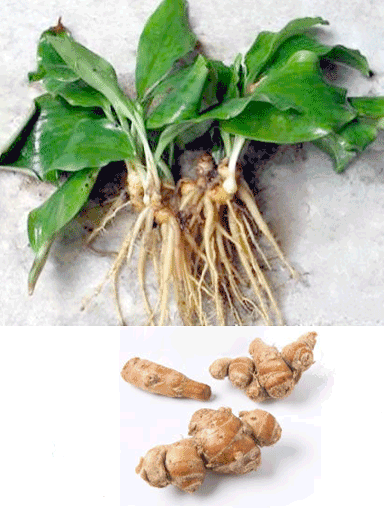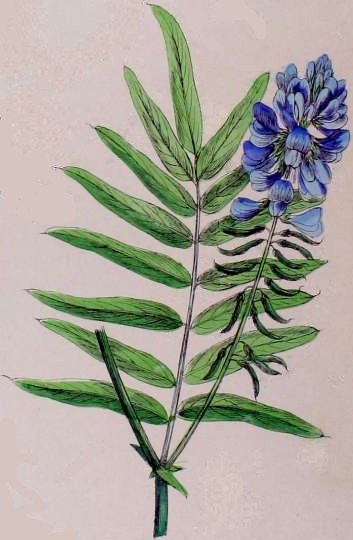ga·lan·gal (gə lang´gəl) n. 1 any of several species bearing aromatic roots, and closely related within the ginger family (especially Alpinia galanga Willd., Boesenbergia rotunda (L.) Mansf., Kaempferia galanga L., and Languas officinarum (Hance) P.H.Hô, all of the Zingiberaceae), and which are used as spice and as medicine. 2 the harvested roots of any of these species, either fresh or prepared. [< Mandarin 高良薑 mild ginger from Ge]
gal·e·ric·u·late (gal´ə rik´yu̇ lāt) adj. bearing a cover or cap. [NL < L galericulum cap, helmet + -ātus provided with]
gal·in·gale (gal´in gāl´) n. 1 an Eurasian semiaquatic graminoid (Cyperus longus L., of the Cyperaceae), which bears aromatic rhizomes, used in perfume. 2 galangal. [ME < OE gallengar < OF galingal < Ar. k̠alanjān < Mandarin 高良薑 mild ginger from Ge]
gam·o·chla·myd·e·ous (gam´ō kHlə mid´ē əs) adj. pertaining to or having the sepals and petals of an inflorescence adnate to the androecium and/or gynoecium. [< Gk. gamos γάμος a marriage + chlamydos χλαμύδος cloak, mantle + L -eus similarity]
gam·o·phyl·lous (gam´ō fil´əs) adj. of leaves or bracts, being partially or completely fused along their adjoining edges. [< NL < Gk. gamos γάμος a marriage + phýllon φύλλον leaf + L -ōsus full of, prone to]
gar·ban·zo (gär bän´zō) n. chickpea. [Sp.]
ge·nip (ge nip´) n. 1 a tree (Melicoccus bijugatus Jacq., of the Sapindaceae) native to coastal dry forests in South America, and now naturalised in the Caribbean and elsewhere. Its leaves are alternate and bijugate. 2 the edible fruit of this tree, a roughly globose green drupe with a juicy meso- and endocarp which serves as a source of vitamin C, as well as dying textiles dark brown. 3 genipap. [distortion of E genipap]
gen·i·pap (djen´i pap´) n. 1 a small tree native to rainforests of South America (Genipa americana L., of the Rubiaceae), whose fruit are used to prepare beverages, as well as medically as an astringent, or to temporarily tattoo the outer layers of a person’s skin dark blue or black. It bears opposite lanceolate leaves. 2 the edible fruit of this tree, a large berry. [< Pg. genipapo < Tupi ianipaba]
gentle cork n. in the harvesting of cork, that commercially usable cork recovered following the first two harvestings of a given tree. [< Sp. gentil delicate, noble < L gentilis of the same clan]
ghyll (gil) n. 1 a deep narrow ravine bearing treecover; gill². 2 a mountain stream-channel. [ME < ON gil deep glen]
gill² (gil) n. 1 a deep narrow ravine bearing treecover; ghyll. 2 a mountain stream-channel. [ME < ON gil deep glen]
glad (glad) n. glads. Informal. gladiolus, either the plant or (more frequently) the flower.
glass·wort (glas´wôrt) n. an herbal genus (Salicornia L., of the Chenopodiaceae), bearing succulent scale leaves, and whose tissues are burned as a rich source of ash in glassmaking; samphire.
Glastonbury thorn n. any of a series of grafted descendants of a hawthorn tree which was said to have sprung up in Glastonbury, England, following a visit by Joseph of Arimathea. It is reputed to be a sprout from Joseph’s walking stick, and distinguished by flowering twice each year — once on old wood in the spring, and once on new growth in mild weather just past midwinter.
Global Plant Council n. a global coalition of plant and crop science societies, created to bring plant scientists together to work synergistically upon problems of interest to many.
globe·flow·er (glōb´flou´ėr) n. an upright perennial herb native to woods and mountains of northern Europe (Trollius europaeus L., and several related species, all of the Ranunculaceae), bearing numerous yellow sepals forming a globate flower, and palmately-lobed deeply-dentate leaves.
globe lily n. any of a subset of species of the North American Calochortus Pursh (of the Liliaceae), which tend to generate flowers with enclosing globate petals, and to grow in closed forests; fairy lantern.
goat-nut n. jojoba.
goat-rue or goat’s-rue n. 1 a velutinous North American subshrub (Tephrosia virginiana (L.) Pers., of the Fabaceae: Papilionoideae), bearing flowers which are cream and deep pink, and imparipinnate leaves with relatively-wide leaflets. Its tissues are toxic, and the crushed stems have been used as a fish poison. 2 a non-pubescent Eurasian perennial herb (Galega officinalis L., of the Fabaceae: Papilionoideae), bearing white or lilac-pink flowers and imparipinnate leaves with wide pinnæ. Its foliage has been investigated for use in pharmacotherapy of type 2 diabetes in humans.
goats·beard or goat’s beard (gōts´bērd) n. 1 a low herb, native to temperate Eurasia (Tragopogon pratensis L., of the Asteraceae), which bears linear entire leaves, yellow capitula which tend to close at midday, and fruit very similar to those of dandelions. 2 a perennial subshrub native to northern temperate habitats (Aruncus L., especially the tall A. dioicus (Walter) Fernald, of the Rosaceae), which generally bear dentate pinnate compound leaves, and tiny white flowers in elongate spikes.
goat willow n. sallow.
go·ji (gō´dji) n. the fruit of either of two temperate subshrubs (Lycium barbarum L. and/or L. chinense Mill. (both of the Solanaceae), bearing elliptical or ovate leaves and bright orange-red oblong berries; tomatillo; wolfberry. Its fruit is antioxidant, has a number of combined dietary/medicinal effects, and can be advantageous for the treatment of diabetes. —adj. of, or pertaining to, or flavoured with, the goji. [< Mandarin 枸杞 (gǒuqǐ) plum/berry]
golden alexanders n. either of a pair of North American herbs (Zizia aurea (L.) W.D.J.Koch, and Z. aptera (A.Gray) Fernald, both of the Apiaceae), which bear biternate or trifoliate leaves and umbellules of yellow flowers and grow in chernozem prairie or low-lying land; alexanders.
golden chestnut n. an evergreen tree native to the western coastal US (Chrysolepis chrysophylla (Douglas ex Hook.) Hjelmq., of the Fagaceae), producing edible nuts which require 2 years to mature; giant chinquapin.
goose·grass (güs´gras´) n. cleavers. [geese enjoy browsing upon this species]
gos·more (gos´mōr´) n. any of a genus of ruderals much resembling dandelion (Hypochaeris L., of the Asteraceae), bearing a basal rosette of leaves varying from obtuse-dentate to lobed, and yellow or white inflorescences; cat’s-ear. They are native to Europe, Africa and South America, but have spread to western North America. [? < E gossamer]
GPC n. Global Plant Council.
great fleabane n. ploughman’s-spikenard; cinnamon root.
greens·man (grēnz´mən) n. -men. in visual arts, a person responsible for maintaining vegetation upon a movie set.
green·wash·ing (grēn´wä shing) n. Slang. deceptive use of advertising to make a product or organization more attractive to potential green customers. —green´wash, v.
ground-cone n. a parasitic plant genus (Boschniakia C.A.Mey. ex Bong., of the Scrophulariaceae), native to northeastern Asia and northwest North America, which tends to live upon the roots of alders. It has no chlorophyll, and grows upon the roots of a host plant as an upright stalk with a dense spike of brown bracts and tubular flowers, resembling a megastrobilus.
ground·cov·er (ground´kuv´ər) n. 1 in a forest, the mosses, herbs, and low shrubs other than saplings which collectively cover the ground surface. 2 of a plant, extending laterally above the soil surface, whether by spreading leaves, or stolons or rhizomes, or frequent sprouts. 3 in horticulture, such a plant selected for use in heavy shade or to stabilize sloping ground.
ground plum n. 1 an herb native to central North American prairie habitats (Astragalus crassicarpus Nutt., of the Fabaceae: Papilionoideae), growing as a tussock of short stems bearing pinnate leaves, large mauve-blue flowers, and bilocular legumes which become woody, and rest upon the ground at maturity. 2 the often-wrinkled legume of this plant, and its edible seeds.
grov·er (grōv´ėr) n. 1 a dweller in or near a grove of trees. This is more common as a Christian name or surname. 2 a person whose occupation is taking care of a grove of trees and associated vegetation.
guar·rie (gwä´rē) n. a dense shrubby ebony species (Euclea racemosa L., of the Ebenaceae), native to South Africa, and bearing black berries which can be used to make vinegar. [< Khoe gwarri]
gum san·da·rac (gəm san´də rak´) n. a resin, produced by the arar-tree, which has been of use in manuscript production, in perfumery, in medicine, and as a fixative in microscopy and in the arts; sandarac.
gut·ti·fer (gut´i fėr´) n. 1 a plant which exudes gum or resin. 2 a plant of familia Clusiaceae. [NL < L gutti drop, small jug + ferre carry] —gut·tif´er·ous, adj.
Gut·ti·fe·rae (gut´i fėr´ē or gə tif´ə rē´) n. the familia Clusiaceae Lindl., a diverse and largely tropical family of dicot flowering plants, characterised as terrestrial trees, shrubs, and vines, and often offering resin as an attractant to pollinators. This family name has been retained in the current ICN. [< NL Guttiferae Juss.]
gym·no·car·pous (djim´nō kär´pəs) adj. of a fungus or lichen, having the reproductive structures – in this case apothecia – present upon the surface of the thallus. [< Gk. gymnos γυμνος naked + karpos καρπος fruit + -ōsus -ωσις prone to] —gym´no·car´pic, adj.
gy·nan·dro·phore (gī´nan´drə fôr) n. a stalk or stipe raising the pistil and also the stamens above the receptacle, as in familia Capparidaceae and Passifloraceae. [< Gk. gynē γυνή woman + andros ἀνδρός male + phoreus φορεύς a bearer]


